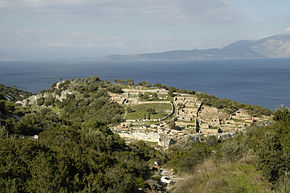Rhamnous
| Ραμνούς | |

View of the site of Rhamnous with Euboea in the background
|
|
| Alternate name | Ramnous, Rhamnus |
|---|---|
| Location | Agia Marina, Attica, Greece |
| Region | Attica |
| Coordinates | 38°13′24″N 24°1′38″E / 38.22333°N 24.02722°ECoordinates: 38°13′24″N 24°1′38″E / 38.22333°N 24.02722°E |
| Type | Settlement |
| History | |
| Periods | Hellenistic |
| Satellite of | Athens |
| Site notes | |
| Condition | Ruined |
| Ownership | Public |
| Management | 2nd Ephorate of Prehistoric and Classical Antiquities |
| Public access | Yes |
| Website | Ramnous |
Rhamnous (Greek: Ῥαμνοῦς), also Ramnous or Rhamnus, was an ancient Greek city in Attica situated on the coast, overlooking the Euboean Strait. Its impressive ruins lie northwest of the modern town of Agia Marina in the municipality of Marathon.
The site was best known in antiquity for its sanctuary of Nemesis, the implacable avenging goddess, her most important in ancient Greece.
Rhamnous is the best-preserved Attic deme site. It was strategically significant on the sea routes and was fortified with an Athenian garrison of ephebes (young men). A fortified acropolis dominates the two small harbours located on either side of it which have silted up extensively since antiquity, and into which grain was imported for Athens during the Peloponnesian War.
Understanding of the history of Rhamnous was greatly improved by the work of Jean Pouilloux, who studied the fortress and the inscriptions from the site.
The sanctuary of Nemesis lies on the road between Rhamnous and Marathon, around 630m south of the later city.
Two temples to Nemesis and Themis can be seen at the site situated very close together.
In modern times, John Peter Gandy's admirable work to document the site was the first in 1813. As a pioneer in a discipline then in its infancy, Gandy recorded in his notes and drawings much information which would otherwise be lost, since the temples in the sanctuary were much better preserved then.
The earliest temple dates from the late 6th century BC, made of Poros stone and known from a few Laconian roof tiles, which was probably destroyed by the Persians in 480-479 BC.
In the early 5th BC the small temple (6.15 by 9.9m) of a 6 × 12 Doric order was built over the earlier remains to both the goddesses Themis and Nemesis, indicated by dedicatory inscriptions on two marble seats of the 4th century BC that were sited on the porch. The former was the personification of Right Order and the latter the avenger of Order's transgressors.
There are several cuttings on the steps of this temple for the insertion of stelai. The temple was built of local dark marble and roofed with terracotta tiles. The walls of the cella and the terrace of the sanctuary platform are built in the Lesbian polygonal style of masonry. This temple probably served later as a treasury of the large temple for its cult statues.
...
Wikipedia

